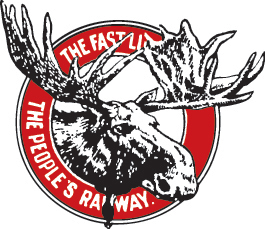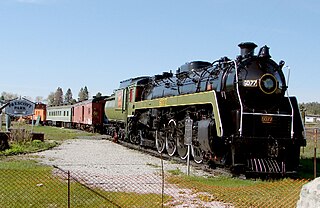Related Research Articles

A hobo is a migrant worker in the United States. Hoboes, tramps, and bums are generally regarded as related, but distinct: a hobo travels and is willing to work; a tramp travels, but avoids work if possible; a bum neither travels nor works.

Cumberland County is a county in the Canadian province of Nova Scotia.

The Intercolonial Railway of Canada, also referred to as the Intercolonial Railway (ICR), was a historic Canadian railway that operated from 1872 to 1918, when it became part of Canadian National Railways. As the railway was also completely owned and controlled by the Government of Canada, the Intercolonial was also one of Canada's first Crown corporations.

Capreol is a community in the Ontario city of Greater Sudbury. Situated on the Vermilion River, Capreol is the city's northernmost populated area.

Featherstone is a town and civil parish in the City of Wakefield, West Yorkshire, England, two miles south-west of Pontefract. Historically part of the West Riding of Yorkshire, in 2011 it had a population of 15,244. Featherstone railway station is on the Pontefract Line.

Sussex is a town in Kings County, New Brunswick, Canada. Sussex is located in south central New Brunswick, between the province's three largest cities, Saint John, Moncton, and Fredericton.
Falconbridge Nickel Mines Limited was a Canadian mining company with operations in 18 countries, involved in the exploration, mining, processing, and marketing of metal and mineral products, including nickel, copper, cobalt, and platinum. In 1982 the company was renamed Falconbridge Limited. It was listed on the TSX and NYSE (FAL), and had revenue of US$6.9 billion in 2005. In August 2006, it was absorbed by Swiss-based mining company Xstrata, which had formerly been a major shareholder. On 28 October 2007, Falconbridge Limited changed its name to the Xstrata Canada Corporation.
The National Transcontinental Railway (NTR) was a historic railway between Winnipeg, Manitoba, and Moncton, New Brunswick, in Canada. Much of the line is now operated by the Canadian National Railway.

Halifax Minster is the minster church of Halifax, Calderdale, West Yorkshire, England. The church is dedicated to St John the Baptist. The parish church of the town, it was granted minster status in 2009. Halifax Minster is one of three churches in the county of West Yorkshire to be given this honorific title; the other two are Dewsbury Minster and Leeds Minster.
The New Brunswick East Coast Railway was a railway that operated in the Canadian province of New Brunswick.

The Atlantic was a passenger train operated by Via Rail, serving both Canadian and U.S. territory between Montreal, Quebec, and Halifax, Nova Scotia. It was previously operated by Canadian Pacific Railway as The Atlantic Limited between Montreal and Saint John, New Brunswick. It formed part of the transcontinental service for both systems.
Glace Bay is a community in the eastern part of the Cape Breton Regional Municipality in Nova Scotia, Canada. It forms part of the general area referred to as Industrial Cape Breton.

The Sydney and Louisburg Railway (S&L) was a Canadian railway. Built to transport coal from various mines to the ports of Sydney and Louisbourg, the S&L operated in the eastern part of Cape Breton County, Nova Scotia. The railway uses a slightly different spelling for the town of "Louisbourg".

The Halifax and South Western Railway was a historic Canadian railway operating in the province of Nova Scotia.
The New Brunswick Railway Museum, owned and operated by the Canadian Railroad Historical Association, New Brunswick Division, is a museum located in Hillsborough, New Brunswick consisting of the railway's line last remaining steam engine. It was formerly known as the Salem and Hillsborough Railroad (S&H) before the rails were superseded by Highway 114.
Springhill Junction is a rural community in central Cumberland County, Nova Scotia, Canada. It is approximately 4 kilometres (2.5 mi) northwest of Springhill, Nova Scotia.
The Bathurst Mining Camp is a mining district in northeast New Brunswick, Canada, centred in the Nepisiguit River valley, and near to Bathurst. The camp hosts 45 known volcanogenic massive sulfide (VMS) deposits typical of the Appalachian Mountains. Some of the ore is smelted at the Belledune facility of Xstrata. Although the primary commodity is zinc, the massive-sulphide ore body produces lead, zinc, copper, silver, gold, bismuth, antimony and cadmium.
McGivney is a settlement in New Brunswick, located 14.78 km SW of Boiestown, on the Canadian National Railway line, in Stanley Parish, York County.

Hackberry is an unincorporated community and census-designated place (CDP) in Mohave County, Arizona, United States. It is located on Arizona State Route 66 28 miles (45 km) northeast of Kingman. Hackberry has a post office which as of 2015 served 68 residential mailboxes with ZIP code 86411. As of the 2020 census, Hackberry had a population of 103.
References
- ↑ "Place Names of New Brunswick: Where is Home? New Brunswick Communities Past and Present [Napadogan]". Provincial Archives of New Brunswick. Retrieved 2019-06-09.
- ↑ "Mining expert warns New Brunswickers about the company behind the Sisson Mine project". NB Media Co-op. Retrieved 2019-06-09.
- ↑ "One year later: First Nations life at the proposed Sisson mine site | CBC News".
46°24′00″N66°55′01″W / 46.400°N 66.917°W